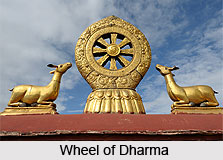 Wheel of Dharma is an important Buddhist symbol that represents the teachings of Buddha. It is also referred to as the `wheel of law.` The turning of the wheel is symbolic of the spiritual metamorphosis that was propagated by Gautama Buddha. This symbol is the oldest one in Indian art. Throughout the world the Wheel of Dharma is a symbol for Buddhism. There are eight spokes in this wheel. Each of these spokes represents the Eightfold Paths of Buddhism. They are believed to have sharp edges that have the power to cut through ignorance.
Wheel of Dharma is an important Buddhist symbol that represents the teachings of Buddha. It is also referred to as the `wheel of law.` The turning of the wheel is symbolic of the spiritual metamorphosis that was propagated by Gautama Buddha. This symbol is the oldest one in Indian art. Throughout the world the Wheel of Dharma is a symbol for Buddhism. There are eight spokes in this wheel. Each of these spokes represents the Eightfold Paths of Buddhism. They are believed to have sharp edges that have the power to cut through ignorance.
The different parts of the chakra symbolize different ideas. The circular shape of the wheel of Dharma presents the perfection of the teachings. The hub of the wheel symbolizes the need for meditation. The rim stands for the mindfulness or samadhi. The hand gesture is known as the Dharmachakra Mudra. The dhamma wheel also stands for the spread of Buddhism in different parts of the world such as India, East Asia, Central Asia and South East Asia.
Wheel of Dharma is also said to represent the cycle of birth and rebirth. For escaping this worldly cycle one has to follow the teachings of Buddha. According to some Buddhists the three parts of the wheel represents the three trainings of Buddhism. The hub of the wheel stands for ethical discipline, which helps to stabilize the mind. The spokes represent wisdom that is used to defeat ignorance and thus gain enlightenment. The rim symbolizes concentration, which is the key to achieve the principles.
Wheel of Dharma was also a well-known symbol for Buddhist art. In ancient times Wheel of Dharma was a symbol for Buddha himself. Ashoka built four pillars and on top of them were four carved lions facing four directions. It symbolized the spread of Buddhism to four corners of the world. In modern times Dharmachakra is the Buddhist art. In these images Buddha is seen with the wheel in his palms and soles of his feet. The wheel is also central to the manadalas or the geometric representation of Buddha`s universe.




















